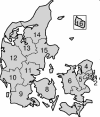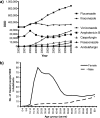National surveillance of fungemia in Denmark (2004 to 2009)
- PMID: 20980569
- PMCID: PMC3020479
- DOI: 10.1128/JCM.01811-10
National surveillance of fungemia in Denmark (2004 to 2009)
Abstract
A 6-year nationwide study of fungemia in Denmark was performed using data from an active fungemia surveillance program and from laboratory information systems in nonparticipating regions. A total of 2,820 episodes of fungemia were recorded. The incidence increased from 2004 to 2007 (7.7 to 9.6/100,000) and decreased slightly from 2008 to 2009 (8.7 to 8.6/100,000). The highest incidences were seen at the extremes of age (i.e., 11.3 and 37.1/100,000 for those <1 and 70 to 79 years old, respectively). The rate was higher for males than for females (10.1 versus 7.6/100,000, P = 0.003), with the largest difference observed for patients >50 years of age. The species distribution varied significantly by both age and gender. Candida species accounted for 98% of the pathogens, and C. albicans was predominant, although the proportion decreased (64.4% to 53.2%, P < 0.0001). C. glabrata ranked second, and the proportion increased (16.5% to 25.9%, P = 0.003). C. glabrata was more common in adults and females than in children and males, whereas C. tropicalis was more common in males (P = 0.020). C. krusei was a rare isolate (4.1%) except at one university hospital. Acquired resistance to amphotericin and echinocandins was rare. However, resistance to fluconazole (MIC of >4 μg/ml) occurred in C. albicans (7/1,183 [0.6%]), C. dubliniensis (2/65 [3.1%]), C. parapsilosis (5/83 [6.0%]), and C. tropicalis (7/104 [6.7%]). Overall, 70.8% of fungemia isolates were fully fluconazole susceptible, but the proportion decreased (79.7% to 68.9%, P = 0.02). The study confirmed an incidence rate of fungemia in Denmark three times higher than those in other Nordic countries and identified marked differences related to age and gender. Decreased susceptibility to fluconazole was frequent and increasing.
Figures




References
-
- Abi-Said, D., E. Anaissie, O. Uzun, I. Raad, H. Pinzcowski, and S. Vartivarian. 1997. The epidemiology of hematogenous candidiasis caused by different Candida species. Clin. Infect. Dis. 24:1122-1128. - PubMed
-
- Ahlquist, A., M. M. Farley, L. H. Harrison, W. S. Baughman, S. S. Magill, and T. Chiller. 2009. Epidemiology of candidemia in metropolitan Atlanta and Baltimore City and County: preliminary results of population-based active, laboratory surveillance—2008-2009, abstr. M-1241. Abstr. 49th Intersci. Conf. Antimicrob. Agents Chemother.
-
- Almirante, B., D. Rodriguez, B. J. Park, M. Cuenca-Estrella, A. M. Planes, M. Almela, J. Mensa, F. Sanchez, J. Ayats, M. Gimenez, P. Saballs, S. K. Fridkin, J. Morgan, J. L. Rodriguez-Tudela, D. W. Warnock, and A. Pahissa. 2005. Epidemiology and predictors of mortality in cases of Candida bloodstream infection: results from population-based surveillance, Barcelona, Spain, from 2002 to 2003. J. Clin. Microbiol. 43:1829-1835. - PMC - PubMed
-
- Arendrup, M. C. 2010. Epidemiology of invasive candidiasis. Curr. Opin. Crit. Care 16:445-452. - PubMed
-
- Arendrup, M. C., K. Fuursted, B. Gahrn-Hansen, I. M. Jensen, J. D. Knudsen, B. Lundgren, H. C. Schonheyder, and M. Tvede. 2005. Seminational surveillance of fungemia in Denmark: notably high rates of fungemia and numbers of isolates with reduced azole susceptibility. J. Clin. Microbiol. 43:4434-4440. - PMC - PubMed
Publication types
MeSH terms
LinkOut - more resources
Full Text Sources
Medical

